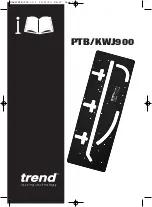
28
Cutting angle setting
The tilt can be adjusted between 0° and 45° with two
distinct directions.
1. Unplug the power cord (10);
2. Loosen the fixing screws and remove the cover of the
base plate (13);
3. Remove the dust extraction port (11);
4. Loosen the fixing screw of the base plate;
5. Adjust the base plate gear on the saw blade gear
according to the desired tilt. Check the angle on the
cutting angle scale (12);
0° - Vertical cut;
45° - Bevel cut (left and right);
6. Screw the base plate fixing screw and assemble the
remaining parts in the reverse order of disassembly;
Adjusting the parallel guide
The parallel guide (2) is used to perform a parallel cut to
the end (edge) of the workpiece.
1. Loosen the parallel guide fixing screws (2);
2. Set the guide according to the desired cutting width.
The cutting width value is shown by the base plate
notch (13), in the scale of the parallel guide rail (2);
3. Tighten the fixing screws;
Starting and stopping the jigsaw
1. Place the base plate (13) over the workpiece;
2. Press the ON/OFF switch lock-on button (8) and the
ON/OFF switch simultaneously (7);
If you do not press the lock-on button, the ON/OFF
switch remains locked;
3. Let the saw blade reach its maximum speed. After
that, direct the blade towards the point you want to
start cutting;
4. Apply a slight pressure over the jigsaw towards the
workpiece to avoid vibrations or the possibility of
breaking the blade;
5. Guide slowly the jigsaw so the saw blade can move
along the cutting line drawn on the workpiece the cut is
finished;
6. To turn the jigsaw off, release the ON/OFF switch;
Speed setting
The rotation speed can be adjusted using the ON/OFF
switch (7). The blade speed increases as the ON/ OFF
switch is pressed. When the switch is completely
pressed, the blade reaches its maximum speed.
Blade pendulum stroke setting
The adjustment of the pendulum stroke of the blade is
controlled in the pendulum stroke selector (5) with 3
different positions (0, 1, 2 and 3).
▪
Position 0
–
no pendulum movement:
- Cuts in hard materials (ceramics or steel) and thin
pieces (steel plate);
- Cuts in sharp edges;
▪
Position 1
–
slight pendulum movement:
Cuts in medium hard materials (for ex. hard wood or
plastic);
▪
Positions
2/3
-
medium/intense
pendulum
movement:
Soft materials (wood and plastic);
Cuts in the direction of the fibers;
The best combination between the blade speed and the
pendulum movement depends on the material to be
worked. To determinate the ideal adjustment makes a
test cut on a piece of waste.














































